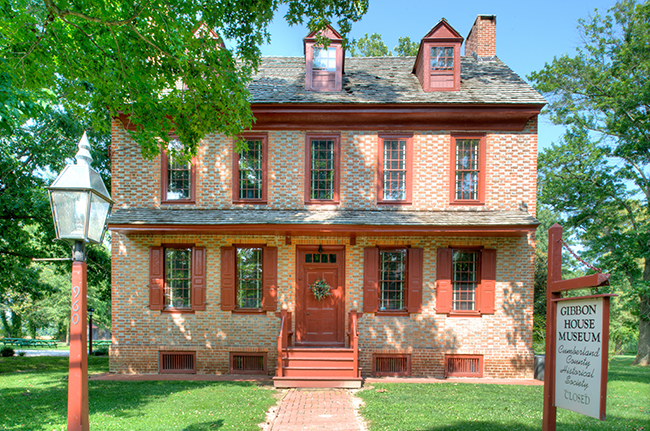Municipality: Greenwich
Category: Residence, Single-Family
In 1677 Edmund Gibbon, an English merchant living in New York, was paid an owed debt by two brothers, Edward and Thomas Duke. The payment consisted of 6,000 acres of land in West Jersey. While today we often refer to New Jersey as either South Jersey or North Jersey, from 1674 until 1702 when New Jersey becomes an official royal colony, the region consisted of two distinct divisions known as East Jersey and West Jersey. The land paid to Edmund Gibbon included what is today Roadstown and other parts of Stow Creek Township and much of Greenwich, including what is today Pine Mount and the Head of Greenwich, but which back then was named “Mount Gibbon.” This land passed down in the Gibbon family until in 1728 brothers Nicholas and Leonard Gibbon inherited it with the stipulation that they leave England and settle on the property in West Jersey.
When the brothers arrived in West Jersey they split the land into two halves. Nicholas took possession of the southern portion, which included a grist mill and about 2,000 acres. Leonard took the northern portion and built a house about two miles northwest of Greenwich.
In 1729, Nicholas purchased a 16-acre building lot in the village of Greenwich where he built his house in 1730. Nicholas was a merchant and was in partnership with Samuel Fenwick Hedge and Captain James Gould. James Gould was headquartered in New York while Nicholas kept a store in Greenwich, shipping furs, hides, cedar shingles, barrel staves, and hoops to New York and the West Indies.
In 1731, Nicholas’ business partner, Samuel Fenwick Hedge died, leaving his wife, Anne Grant and two children. Stories speak of Anne Grant being one of the most beautiful women of Greenwich, and Nicholas wasted no time in courting and marrying her. Nicholas and his new wife lived in the house until 1740, when they moved to Salem. Although they lived in Greenwich for only ten years, while here they lived well. Three of their five children were born in the house – Nicholas, who died at the young age of sixteen; Grant, who was an ardent supporter of American independence and was elected to the State Assembly in 1772; and their first daughter, Jane, who was born in 1736.
The house as designed is reminiscent of townhouses in London of the time. All the rage in London at that time was a type of architecture which became known as Georgian, referring to the first four monarchs of the House of Hanover who ruled during that period: George I, George II, George III, and George IV. As with most trends British during that time, the Georgian style of architecture was brought to the American colonies, where it was used extensively in many upper class residences. The wealth and up-to-date tastes of Nicholas Gibbon were expressed through the design of his home, with large windows of nine panes of glass over nine panes of glass. The brick, fired on the property, was laid in the Flemish Bond pattern with a red stretcher, or long end of a brick, and blue glazed header, or short end of a brick, creating a pattern brought to America from the counties of Kent and Sussex in England. Above the first floor windows and door along the front of the house was built a small roof known as a pent eave.
Nicholas Gibbon died in 1758 and his son, Grant, sold the house to Richard Wood, a member of the New Jersey Assembly. It remained in the Wood family’s possession for nearly two hundred years. The house was sold by the Wood family in 1934 and quickly went through a succession of owners before being purchased by the Cumberland County Historical Society for use as their headquarters in 1969. The Gibbon House is a contributing members of the Greenwich Historic District and is open for tours and special events.

